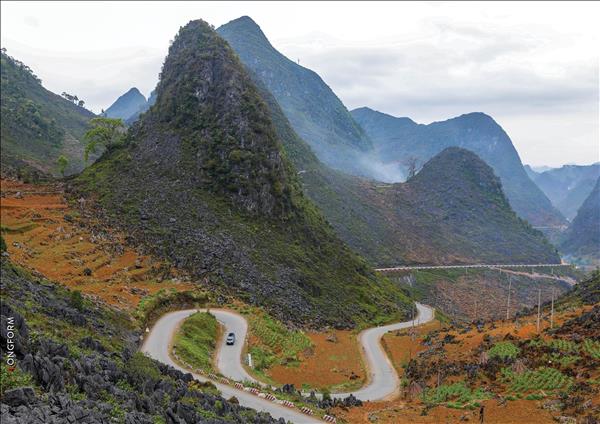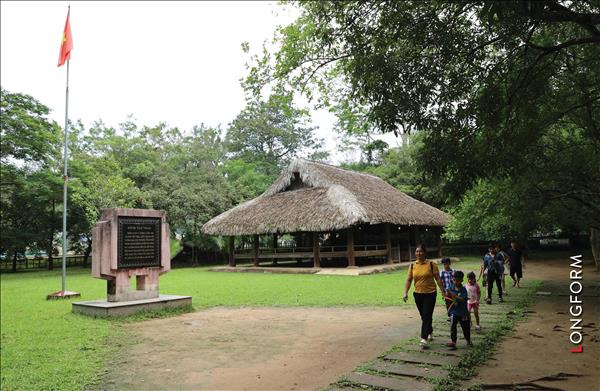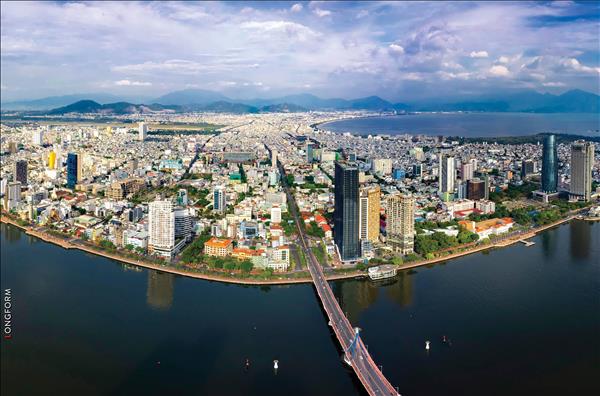A breakthrough in the US market
The leather industry is Vietnam’s traditional industry. There are many craft villages and wards known for their hand-made footwear by noted artisans. For instance, in Ho Chi Minh City, there is a traditional shoe-making village in District 4, with artisan Trinh Ngoc once made shoes for Cambodian King Sihanouk. Nowadays, Vietnam’s leather industry has developed vigorously with over 550 enterprises nationwide, employing about 600,000 workers and exporting their products to more than 50 countries and territories.
Vietnam once had the advantage of processing exported leather articles. Over the past 20 years, thanks to its preferential policies, Vietnam has attracted many investors, domestic and foreign as well, into the leather industry. Many large-scale and modern equipped factories have been built in various big industrial parks in Ho Chi Minh City, Binh Duong, Dong Nai and Hai Phong. Alongside, due to people’s higher living standards with higher incomes, leather enterprises have strongly developed systems of modern leather articles shops and department stores with a view to meeting higher domestic demands.
According to the Vietnam Federation of Leather Enterprises (Lefaso), in 2015, the export of leather articles rose in almost all markets, including the United States to 5.1 billion dollars accounting for 43% of the total turnover, up by 50% over 2014; the EU with 4.4 billion dollars representing 30% plus of the total turnover, up by 20%; which was followed by Japan and China.
Formerly, the EU took the lead in Vietnam’s leather exports, which has now been replaced by the United States. For the first quarter of this year alone, exports to the US were at 918 million dollars, up by 12% over the same period last year. This shows that the United States has become a large market, especially after the bilateral relationship between the two countries was heightened to the level of comprehensive partnership.
A recent study by the Vietnam Institute of Leather Industry revealed the US Shoe Retail Association had remarked that the competitive potential of Vietnam’s leather industry is quite good thanks to its economic, monetary, political and social stability; large contingent of cheap and skilled labourers and its golden population period with 42.1% of the labourers aged under 25 years old.
This shows that Vietnam’s export leather markets have been constantly expanded from the traditional markets to more potential ones, particularly countries in such new FTAs as those in the EU and the Trans-Pacific Partnership (TPP).
Ready for big games
Vietnam’s leather industry wants to reach exports of 54 billion dollars in 2030. To this end, it is recommended to make the fullest use of advantages of the new FTA agreements to be concluded soon.
According to Phan Thi Thanh Xuan, Lefaso’s General Secretary, the leather industry will greatly benefit when Vietnam is deeply involved in these FTAs. Taking the US market for example, prior to TPP, Vietnam’s leather article export increased by 50%, accounting for 8.2% of the market. If FTAs come into force with the 0% tax rate, great opportunities will open up for the leather industry in the US. Or for the EU , Vietnam’s leather industry only accounts for 11% of the market at present, which will certainly rise when FTA takes effect.
Currently, to be ready to approach the new FTAs, leather enterprises have actively updated information on the FTAs, restructured their production, trained quality human resources and sought sources of preferential loans.
In Ho Chi Minh City- the “capital” of Vietnam’s leather industry, big enterprises like Biti’s, Bita’s, Vina Giay, Giay Thai Binh, Giay Sai Gon and Giay Gia Dinh have prepared for these big changes.
For example, Biti’s, a strong national brand, has clearly identified its objective in the integration process, which is to sell Vietnamese footwear products around the world. As a result, Biti’s products have been exported to more than 40 countries, including big countries with developed leather industries such as Italy, France, the United Kingdom, the United States, Russia, Japan, South America and Mexico.
Vina Giay is also a big name in Vietnam, which has joined Ho Chi Minh City’s footwear market fairly early at the beginning of the 1990s. Once a family business with a traditional shoe-making craft, Vina Giay soon changed its production thinking towards modernisation so as to control the domestic and overseas markets, becoming a member of many well-known Leather Federations in the world such as SATRA in the United Kingdom and NSRA in the United States.
Unlike enterprises specialising in the manufacturing of footwear, the Hoa Ca Crocodile Company owned by Ton That Hung, has chosen its own way by producing high-grade fine-art handicraft articles of crocodile skin. Products like wallets, belts, watch bands and handbags are skillfully handmade, which are as elegant as those of great world brands but lower priced, hence their high competitiveness.
However, despite its great potentials and extremely great opportunity, Vietnam’s leather industry is also confronted with big challenges. According to Lefaso, Vietnam’s leather industry must strive to raise the localisation rate to 60% in order to meet all conditions on the origin regulations for the concluded FTA agreements, thereby to reduce freights and increase the imitations of Vietnamese enterprises.
Regarding the long-term and sustainable vision, Deputy Minister of Industry and Trade Ho Thi Kim Thoa affirmed in its development master plan, the leather industry will construct a number of industrial parks or clusters to produce accessories for concentrated environmental treatment; and at the same time build a number of materials and raw materials production clusters to call for investment. The leather industry will build and develop human resource training establishments, trade promotion centres and fashion centres at home and overseas.
Vietnam’s leather industry has made fundamental preparations for a big game with a view to creating big breakthroughs, including the target of an export turnover of 54 billion in dollars 2030.
The leather industry is Vietnam’s traditional industry. There are many craft villages and wards known for their hand-made footwear by noted artisans. For instance, in Ho Chi Minh City, there is a traditional shoe-making village in District 4, with artisan Trinh Ngoc once made shoes for Cambodian King Sihanouk. Nowadays, Vietnam’s leather industry has developed vigorously with over 550 enterprises nationwide, employing about 600,000 workers and exporting their products to more than 50 countries and territories.
|
Vietnam’s leather and footwear sector promotes investment in technology to enhance production effectiveness. Photo: Dang Kim Phuong/VNP  Enterprises have bravely innovated their technology for integration. Photo: Dang Kim Phuong/VNP 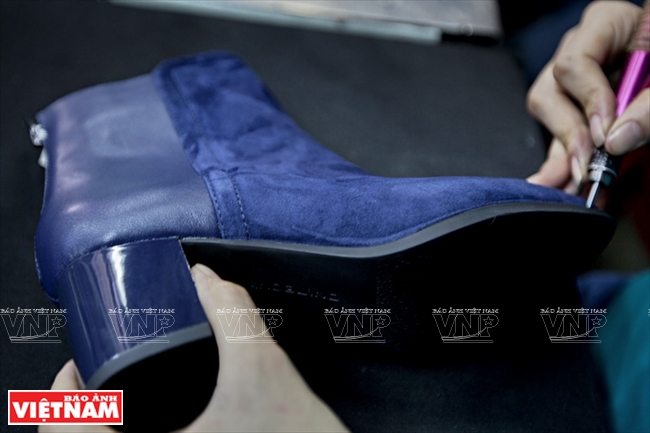 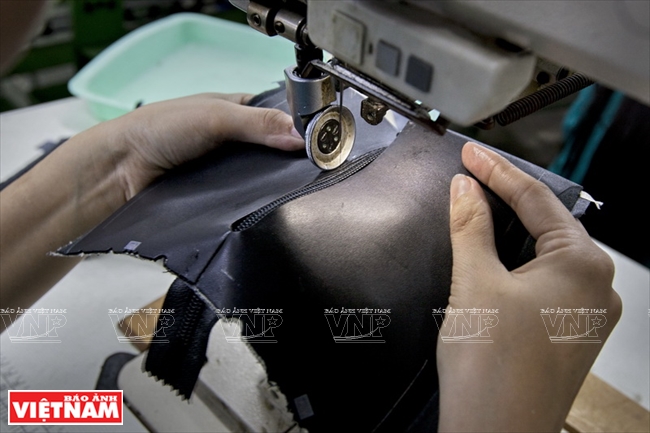 Thanks to skilled employees, Vietnam’s leather and footwear products always meet the requirements of customers. Photo: Dang Kim Phuong/VNP 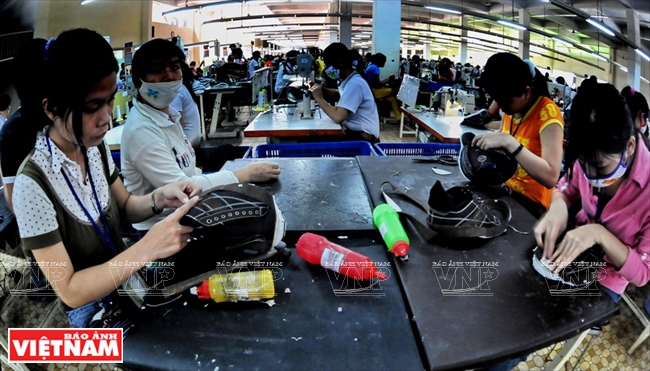 Vietnam has an abundant labour force of professionals working for a cheap price. Photo: Dang Kim Phuong/VNP 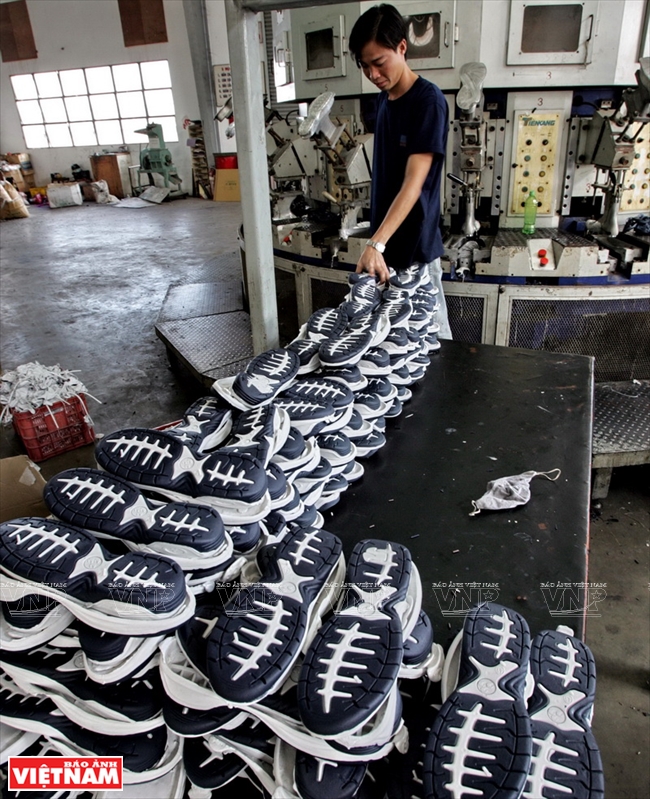 A system of modern sole pressing machines at Bita’s. Photo: Trong Chinh/VNP 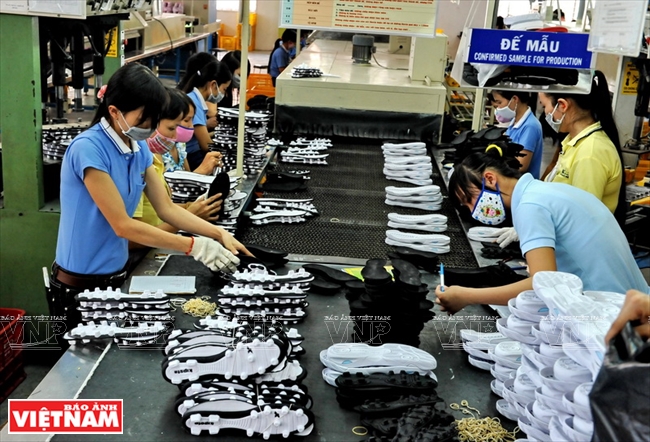 The leather and footwear sector will enjoy great benefits when Vietnam signs new FTAs. Photo: Dang Kim Phuong/VNP 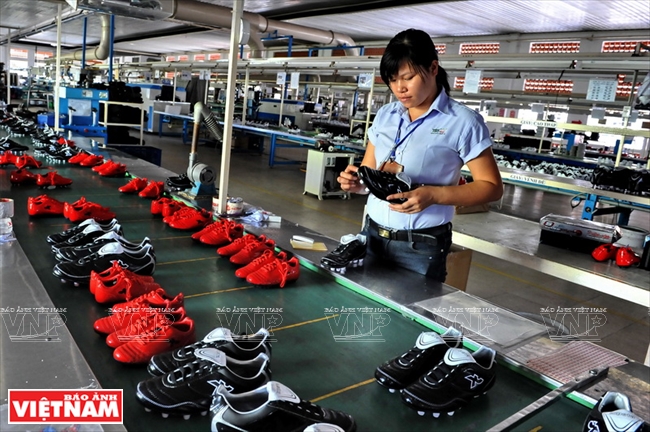 Footwear is one of key exports to the markets of TPP, EU and the Customs Union of Russia – Belarus – Kazakhstan. Photo: Dang Kim Phuong/VNP |
| At present, there exist in Vietnam more than 550 leather enterprises, employing over 600,000 labourers. The leather industry’s exports account for 8-10% of the country’s annual total export turnover, with its key export items ranking third after textiles and assorted telephones and accessories. Its exports reached 8.76 billion dollars in 2012; 8.4 billion dollars in 2013; 10.3 billion dollars in 2014 and 14.88 billion dollars in 2015, which is expected to rise to 17 billion dollars in 2016. |
According to the Vietnam Federation of Leather Enterprises (Lefaso), in 2015, the export of leather articles rose in almost all markets, including the United States to 5.1 billion dollars accounting for 43% of the total turnover, up by 50% over 2014; the EU with 4.4 billion dollars representing 30% plus of the total turnover, up by 20%; which was followed by Japan and China.
Formerly, the EU took the lead in Vietnam’s leather exports, which has now been replaced by the United States. For the first quarter of this year alone, exports to the US were at 918 million dollars, up by 12% over the same period last year. This shows that the United States has become a large market, especially after the bilateral relationship between the two countries was heightened to the level of comprehensive partnership.
 High quality leather footwear products of Vietnam are now exported to 50 countries and territories in the world. Photo: Dang Kim Phuong/VNP 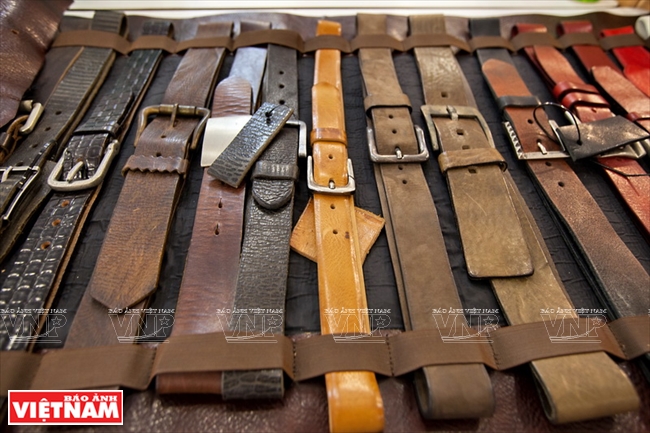 High quality leather belts of Vietnam are sought much after by customers. Photo: Dang Kim Phuong/VNP 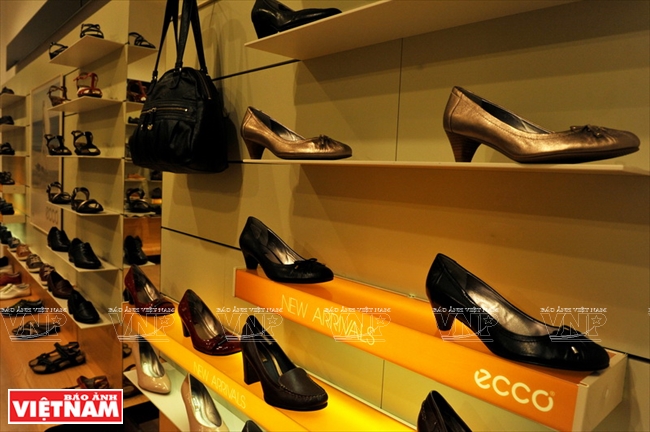 Products of Thai Binh Joint-stock Company. Photo: Dang Kim Phuong/VNP |
A recent study by the Vietnam Institute of Leather Industry revealed the US Shoe Retail Association had remarked that the competitive potential of Vietnam’s leather industry is quite good thanks to its economic, monetary, political and social stability; large contingent of cheap and skilled labourers and its golden population period with 42.1% of the labourers aged under 25 years old.
This shows that Vietnam’s export leather markets have been constantly expanded from the traditional markets to more potential ones, particularly countries in such new FTAs as those in the EU and the Trans-Pacific Partnership (TPP).
Ready for big games
Vietnam’s leather industry wants to reach exports of 54 billion dollars in 2030. To this end, it is recommended to make the fullest use of advantages of the new FTA agreements to be concluded soon.
According to Phan Thi Thanh Xuan, Lefaso’s General Secretary, the leather industry will greatly benefit when Vietnam is deeply involved in these FTAs. Taking the US market for example, prior to TPP, Vietnam’s leather article export increased by 50%, accounting for 8.2% of the market. If FTAs come into force with the 0% tax rate, great opportunities will open up for the leather industry in the US. Or for the EU , Vietnam’s leather industry only accounts for 11% of the market at present, which will certainly rise when FTA takes effect.
  For many years, some enterprises have invested in making high-class materials from raw skin of python, ostrich and crocodile in Cu Chi District, Ho Chi Minh City. Photo: Dang Kim Phuong/VNP - Trong Chinh/VNP  The crocodile leather material of the Hoa Ca Crocodile Co., Ltd. Photo: Dang Kim Phuong/VNP 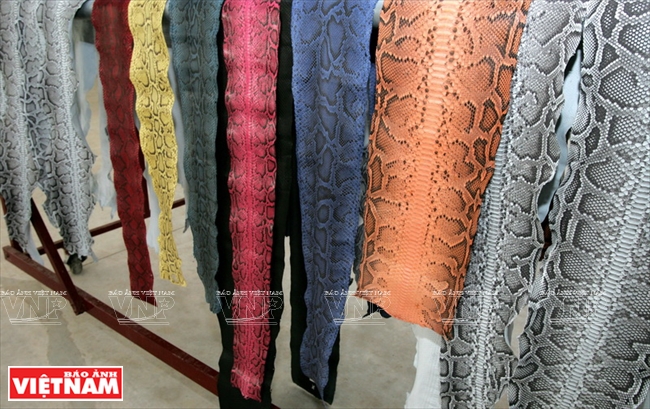 The python leather material of the Hoa Ca Crocodile Co.,Ltd. Photo: Trong Chinh/VNP  Sewing thread of the Thai Binh Joint-stock Company (TBS Group). Photo: Dang Kim Phuong/VNP  Foreign partners learn about the leather material at an international exhibition of leather, footwear and leather products in Vietnam. Photo: Dang Kim Phuong/VNP |
Currently, to be ready to approach the new FTAs, leather enterprises have actively updated information on the FTAs, restructured their production, trained quality human resources and sought sources of preferential loans.
In Ho Chi Minh City- the “capital” of Vietnam’s leather industry, big enterprises like Biti’s, Bita’s, Vina Giay, Giay Thai Binh, Giay Sai Gon and Giay Gia Dinh have prepared for these big changes.
For example, Biti’s, a strong national brand, has clearly identified its objective in the integration process, which is to sell Vietnamese footwear products around the world. As a result, Biti’s products have been exported to more than 40 countries, including big countries with developed leather industries such as Italy, France, the United Kingdom, the United States, Russia, Japan, South America and Mexico.
Vina Giay is also a big name in Vietnam, which has joined Ho Chi Minh City’s footwear market fairly early at the beginning of the 1990s. Once a family business with a traditional shoe-making craft, Vina Giay soon changed its production thinking towards modernisation so as to control the domestic and overseas markets, becoming a member of many well-known Leather Federations in the world such as SATRA in the United Kingdom and NSRA in the United States.
Unlike enterprises specialising in the manufacturing of footwear, the Hoa Ca Crocodile Company owned by Ton That Hung, has chosen its own way by producing high-grade fine-art handicraft articles of crocodile skin. Products like wallets, belts, watch bands and handbags are skillfully handmade, which are as elegant as those of great world brands but lower priced, hence their high competitiveness.
However, despite its great potentials and extremely great opportunity, Vietnam’s leather industry is also confronted with big challenges. According to Lefaso, Vietnam’s leather industry must strive to raise the localisation rate to 60% in order to meet all conditions on the origin regulations for the concluded FTA agreements, thereby to reduce freights and increase the imitations of Vietnamese enterprises.
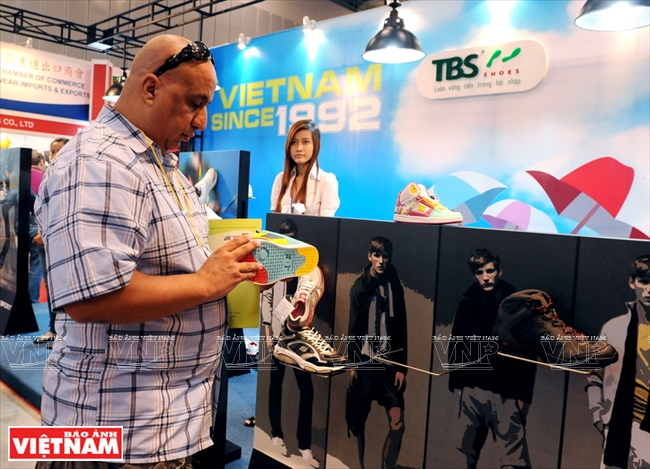 A foreign customer learns about high class footwear of Vietnam. Photo: Dang Kim Phuong/VNP 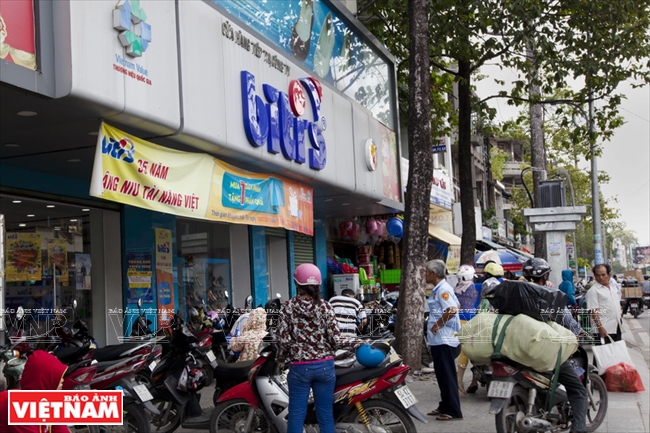 Biti’s is one of the famous footwear brand names in Vietnam which now export to many foreign markets. Photo: Dang Kim Phuong/VNP  A showroom of Thai Binh Joint-stock Company at a Vincom Center in Ho Chi Minh City. Photo: Dang Kim Phuong/VNP 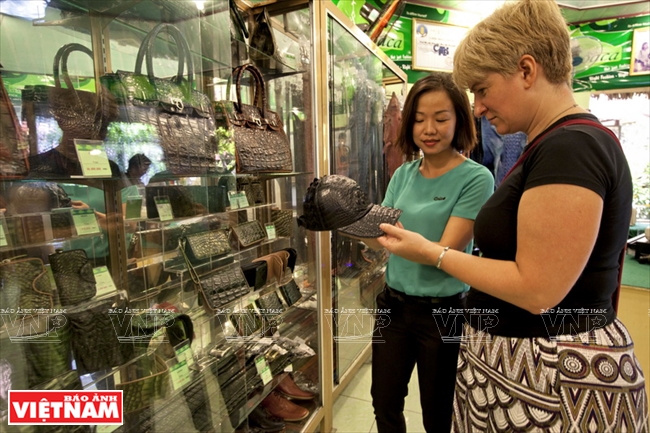 A foreign customer learns about handbags and wallets made from crocodile leather of the Hoa Ca Crocodile Co., Ltd. Photo: Dang Kim Phuong/VNP |
Regarding the long-term and sustainable vision, Deputy Minister of Industry and Trade Ho Thi Kim Thoa affirmed in its development master plan, the leather industry will construct a number of industrial parks or clusters to produce accessories for concentrated environmental treatment; and at the same time build a number of materials and raw materials production clusters to call for investment. The leather industry will build and develop human resource training establishments, trade promotion centres and fashion centres at home and overseas.
Vietnam’s leather industry has made fundamental preparations for a big game with a view to creating big breakthroughs, including the target of an export turnover of 54 billion in dollars 2030.
|
|
Story: Nguyen Vu Thanh Dat - Photos: Dang Kim Phuong & Trong Chinh

